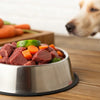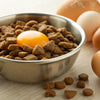How Much Raw Food to Feed a 60 lb Dog: An Essential Guide for Pet Owners
- Houndsy
Table of Contents
- Introduction
- Understanding Raw Dog Food Benefits
- How Much Raw Food Should You Feed a 60 lb Dog?
- Transitioning Your Dog to Raw Foods
- Enhancing the Dog Feeding Experience
- FAQs About Raw Feeding for 60 lb Dogs
- Conclusion
Introduction
Did you know that nearly 80% of pet owners worry about whether they are feeding their dogs the right amount of food? For a 60 lb dog, this concern is compounded when considering a raw food diet, which has gained popularity among health-conscious pet parents. With an exciting range of fresh meats and vegetables, the raw feeding movement is all about providing dogs with a nutritious, balanced diet that mimics their natural eating habits.
Understanding how much raw food to feed a 60 lb dog is critical for their well-being, contributing to their energy levels, weight management, and overall health. In this blog post, we will not only dive into specific feeding guidelines but also explore the benefits of a raw diet, how to transition your dog to raw foods, and ways to make the feeding experience enjoyable for both you and your pet.
By the end of this post, you will gain insights into the appropriate raw food portions for your furry friend and practical tips to enhance both their dining experience and your own. So, let’s embark on this journey together with an open mind as we revolutionize our dog's feeding routine!
Understanding Raw Dog Food Benefits
Before we discuss the specifics of feeding a 60 lb dog, it's essential to recognize the reason many pet owners are making the switch to raw diets.
Nutritional Advantages
Raw feeding offers several nutritional benefits compared to traditional kibble, including:
- Higher Nutritional Value: Raw diets tend to contain fewer preservatives and fillers, ensuring dogs get real meat and vegetables.
- Improved Digestion: Raw food can lead to healthier digestion, resulting in firmer stools and less frequent bowel movements.
- Healthier Skin and Coat: Ingredients in raw diets, like omega fatty acids, can improve coat quality and skin health.
- Increased Energy Levels: Many pet owners report enhanced vitality and energy in their dogs after switching to raw food.
These benefits not only foster a happier and healthier pet but also elevate your overall pet ownership experience.
The Importance of Proper Feeding Guidelines
It is crucial to understand proper feeding guidelines, especially when transitioning to raw food. A 60 lb dog's dietary needs should be carefully calculated to avoid overfeeding or underfeeding, both of which can lead to health complications. Let's delve into how much raw food is appropriate for a dog of this weight.
How Much Raw Food Should You Feed a 60 lb Dog?
The general rule of thumb for feeding dogs on a raw diet is that they should consume approximately 2-3% of their ideal body weight daily. For our specific case — a 60 lb dog — this translates to the following calculations:
- 2% of 60 lbs: 1.2 lbs (or about 19.2 oz)
- 2.5% of 60 lbs: 1.5 lbs (or about 24 oz)
- 3% of 60 lbs: 1.8 lbs (or about 28.8 oz)
To summarize, a 60 lb dog would require approximately 1.2 to 1.8 lbs of raw food per day, depending on their activity level, age, and metabolism.
Factors Affecting the Amount to Feed
While the above calculations provide a great starting point, it’s essential to adjust based on the following factors:
- Activity Level: If your dog is very active or works as a service or sporting dog, they may need higher calorie intake (closer to 3% of their body weight).
- Age and Health: Puppies typically require more food to support their growth, while senior dogs might need less as their metabolism slows.
- Body Condition: Regularly assess your dog’s body condition and adjust food intake accordingly. A healthy dog should have a defined waist and ribs that are not overly prominent.
Establishing a Feeding Routine
Creating a consistent feeding routine is important, as this helps dogs recognize when it's time to eat. We recommend introducing meals twice a day for adult dogs, rather than free feeding, to help maintain a healthy weight.
Transitioning Your Dog to Raw Foods
If you are contemplating making the switch to raw food for your 60 lb dog, it's vital to do so gradually. Abrupt changes in diet can lead to gastrointestinal upset. Here are steps to ensure a smooth transition:
- Start With a Mix: Begin by mixing a small amount of raw food with your dog’s current kibble, slowly increasing the raw component over a week or two.
- Choose Quality Ingredients: Prioritize high-quality, human-grade meats and vegetables. Opt for a balanced mix of protein, healthy fats, and carbohydrates.
- Monitor Digestive Health: Keep an eye on your dog’s stool consistency. Loose stools or allergies can indicate that the transition is too fast; slow down and adjust.
- Experiment with Varieties: Dogs may thrive on different protein sources, so feel free to rotate between chicken, turkey, beef, lamb, or fish to find what works best.
Enhancing the Dog Feeding Experience
At Houndsy, we believe that feeding your dog should be a rewarding and enjoyable experience. One way to achieve this is through the Houndsy Kibble Dispenser, our innovative product designed to simplify and elevate the feeding ritual.
Why Choose the Houndsy Kibble Dispenser?
- Perfect Portion Control: With an easy-to-use crank at standing height, dispensing the right amount of food has never been so simple. Say goodbye to bending down or messy scooping!
- Stylish Design: Our dispenser features a mid-century modern aesthetic that complements your home decor while providing functional storage for 25-30 lbs of dog food.
- High-Quality Materials: We use BPA-free materials, ensuring that your dog's food remains fresh and safe.
- Reliability: Equipped with an auto-locking mechanism, it prevents accidental dispensing by curious pets or toddlers.
If you're ready to enhance your feeding experience, consider checking out the Houndsy Kibble Dispenser today.
FAQs About Raw Feeding for 60 lb Dogs
1. Can I convert my dog to raw food if they have specific health issues?
Yes, it's possible to transition a dog with health issues to a raw diet, but consult your veterinarian for tailored guidance.
2. What types of raw food can I offer my dog?
Dogs can thrive on a variety of raw foods, including lean meats (like chicken, beef, turkey), organ meats, raw eggs, and vegetables. Remember to maintain a balanced diet.
3. How often should I change protein sources in a raw diet?
It’s prudent to switch proteins every few weeks or months to provide a wider range of nutrients without causing stress to your dog’s digestive system.
4. What are some signs that my dog isn’t adapting well to the raw diet?
Watch for signs like vomiting, diarrhea, or lethargy. If your dog exhibits these symptoms, consult your veterinarian.
5. Is it necessary to add supplements when feeding raw?
Possibly. Depending on your dog's specific needs, adding calcium, omega fatty acids, or other vitamins might be beneficial.
Conclusion
Feeding a raw diet to a 60 lb dog can offer numerous benefits, but it requires diligence, planning, and adjustment based on your dog's individual needs. Begin by calculating their portion size, consider transitioning slowly, and remain attentive to their health throughout the process.
Remember, the feeding experience should be enjoyable; tools like the Houndsy Kibble Dispenser can help streamline your daily routines while providing the functionality and design you desire.
Let's transform our pets' mealtime into a time of joy and health, ensuring they receive the nourishment they need to thrive. As we nurture the well-being of our four-legged friends, let us always be mindful of their specific needs and adapt our approaches accordingly. After all, a healthy dog is a happy dog!













